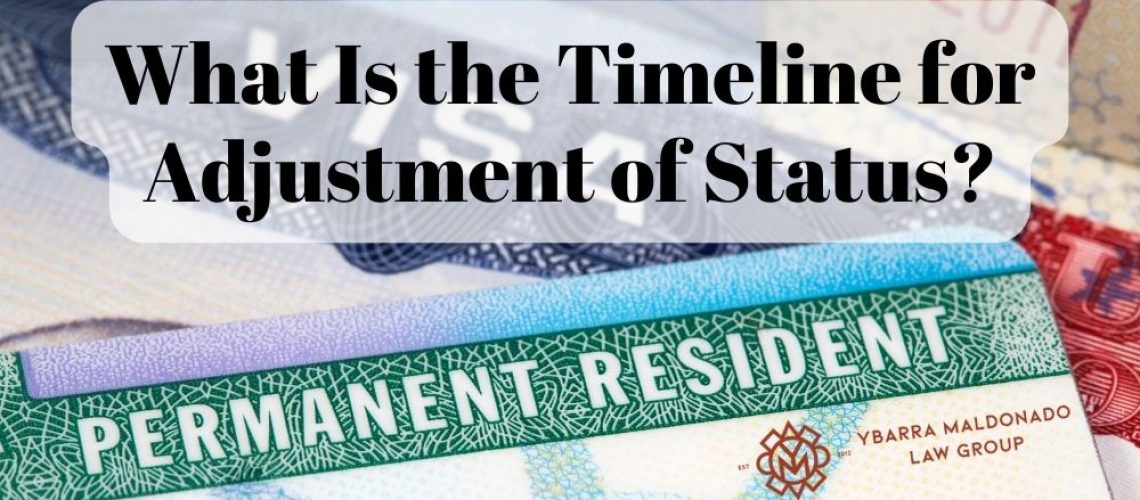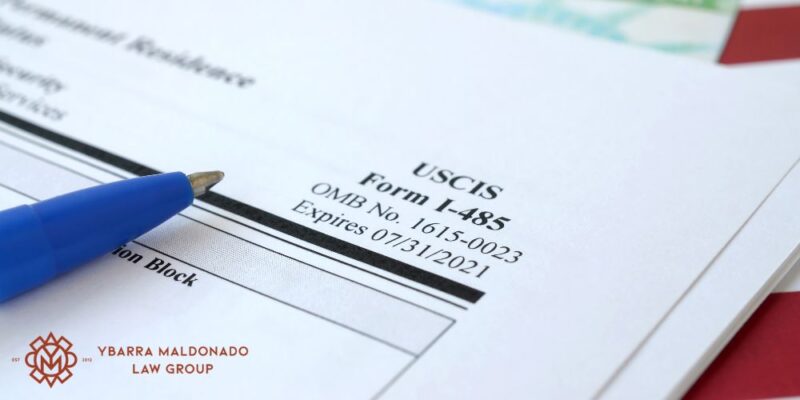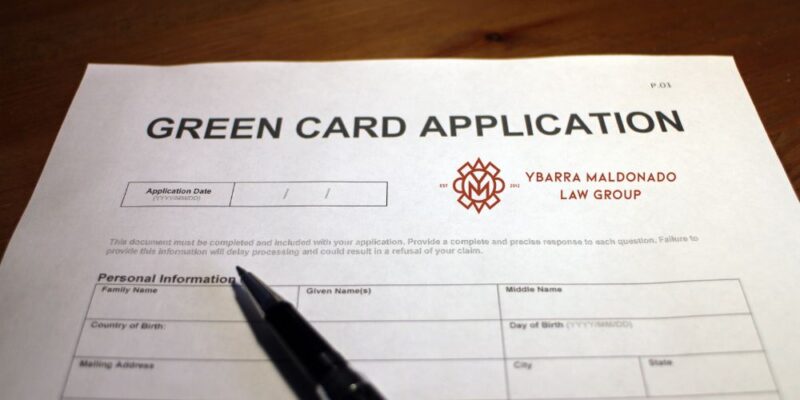The adjustment of status process is reserved for those who enter the United States with temporary visas and want to achieve lawful permanent resident status. This process can be complicated, so we recommend speaking with an experienced Phoenix immigration lawyer before you begin. We can advise you of the timeline for adjustment of status, as well as guide you through the entire process.
The immigration lawyers at Ybarra Maldonado Law Group have extensive experience in immigration law. We can help you fill out and submit your adjustment of status application to ensure everything is done properly the first time. This way, your adjustment of status process can go as smoothly as possible. To schedule your free consultation with us, please call our office at 602-910-4040 today.
What Is Adjustment of Status?
Adjustment of status is a process that immigrants can use to apply for lawful permanent residence when they are already in the United States. It is also known as the process of becoming a green card holder. The process allows one to register permanent residence without returning to their home country for visa processing.
Adjustment of Status vs Consular Processing
Adjustment of status is reserved for those applying for a green card who are already in the United States. Consular processing is the method that immigrants outside the United States use to apply for green cards. When someone undergoes consular processing, they will wait in their home country for their green card approval notice.
What Is Form I-485?
Form I-485 is the Application to Register Permanent Residence or Adjust Status. It is the immigrant petition that allows immigrants within the United States to apply for permanent residency. Being able to remain in the United States while adjusting status is the major benefit of filing Form I-485.
What Are the Other Adjustment of Status Forms?
Most green card applicants must file more than one form for the adjustment of status process. One will be Form I-485, which is submitted after filing an immigrant petition, such as one of the following.
- Petition for Alien Relative, Form I-130
- Immigrant Petition for Alien Worker, Form I-140
- Refugee/Asylum Relative Petition, Form I-730
- Application for Asylum and for Withholding of Removal, Form I-589
- Immigrant Petition for U Nonimmigrant Status, Form I-918
- Petition for Qualifying Family Member of a U-1 Nonimmigrant, Form I-929
- Petition for Amerasian, Widow(er), or Special Immigrant, Form I-360
- Immigrant Petition by Alien Entrepreneur, Form I-526
Some categories allow for “concurrent filing,” which means that the individual can file both their immigrant petition and Form I-485 at the same time. However, most categories require someone to have an approved immigrant petition before they can file Form I-485.
Who Is Eligible for Adjustment of Status?
Generally, an intending immigrant must satisfy three requirements to be eligible for adjustment of status. These requirements are as follows.
- Physical presence in the United States. The adjustment of status process is reserved for immigrants who are physically present in the United States already. They must be in the country when they file and for the duration of the green card process.
- Lawful entry into the United States. This means the immigrant entered the United States with proper documentation and met with an immigration officer who acknowledged your lawful entry. Even if you entered with a valid visa, but it has expired, you still entered the United States lawfully.
- Visa availability. Before submitting an adjustment of status application, we encourage applicants to check visa availability. If someone is an immediate relative of a United States citizen, a visa will be immediately available to them. This is because immediate I-130 petitioners always have available visas. Speak with your immigration attorney for more information on whether or not a visa is available for you.
Steps in the Adjustment of Status Process
Working with an immigration attorney can help ensure that your petition to adjust status proceeds as smoothly as possible. In general, the steps one must take to become a lawful permanent resident include the following.
Determine Your Eligibility
Green card eligibility is available for immigrants in several different categories. Depending on the specific category you file under, your requirements may vary slightly. An attorney can help you determine which immigrant category you fall under. Green card applicants can apply through the following categories, according to USCIS.
- Family category
- Employment category
- Special immigrant category
- Refugee or asylee status category
- Human trafficking and crime victims category
- Victims of abuse category
- Other specific categories
File Your Petition
Once you determine your eligibility for a green card, someone must submit your immigrant petition for you. Most cases require someone else, usually your sponsor, to file your immigrant petition on your behalf. You must also pay the filing fees for all of your forms.
Check Immigrant Visa Availability
Remember that you cannot file Form I-485 unless a visa is available to you in your category. The Immigration and Nationality Act (INA) limits the number of immigrant visas the Department of State may issue for each immigrant category each year. Visas for immediate relatives of United States citizens, however, are unlimited, meaning they are always available for filers.
We recommend speaking with your attorney to determine whether or not an immigrant visa is available in your category.
File Your Form I-485
Now, you may file Form I-485. Your immigration lawyer can walk you through how to fill out and file your application properly. Having an attorney help with this part of the process can prevent any mistakes from happening, preventing your adjustment of status processing time from being delayed.
USCIS Receives Your Application
Once USCIS receives your application, they will mail you a notice. The notice will inform you of your biometrics appointment date, which will take place at your local USCIS Application Support Center.
Attend Your Biometrics Appointment
Your biometrics appointment notice will provide the date, time, and location of your appointment. At your biometrics appointment, USCIS will take your fingerprints, signature, and photograph. USCIS uses this biometric information to confirm your identity and perform background and security checks. They will also ask you to sign a document that states all the information in your application is complete, true, and accurate at the time of filing.
Attend Your Adjustment of Status Interview
Not every applicant must attend an interview at a USCIS office. If USCIS determines that you must attend an interview, they will send you a notice with the interview’s date, time, and location. The interview will require you to answer questions about your Form I-485 under oath. You and the person who filed the petition for you, if applicable, must both attend the interview. USCIS requires you to bring all original copies of your submitted documents, which can include travel documents, passports, or Form I-94.
Provide Additional Evidence, If Requested
If USCIS needs more information from you to make a decision, they will send you a Request for Evidence (RFE). Usually, they will do this if you did not submit enough evidence, if any of the evidence you submitted was invalid, or if the USCIS officer needs more information to decide. If you receive an RFE, it will outline what evidence you must provide. It will also tell you where to submit your evidence and the deadline by which you must submit it.
Check Your Case Status
As you wait for a decision from USCIS, you can check your immigration case status online or call 800-375-5283. To do this, you will likely need to provide your USCIS receipt number, A-number, and date of birth.
Receive Your Decision from USCIS
When USCIS decides on your case, they will send you a written notice of their decision. If they approve your application, they will first send you an approval notice before sending your actual green card.
If the application is denied, USCIS will send you a notice outlining why it was denied, as well as whether or not you can appeal their decision. Generally speaking, applicants cannot appeal a denial for adjustment of status. However, they may file a motion to reconsider or reopen the application.
What Is the Average Total I-485 Processing Time?
Although processing times can vary greatly from case to case, most take anywhere from 8-14 months at least. Depending on the adjustment category you file under, this average range can vary.
How Long Does It Take for Adjustment of Status to Be Approved?
For family-based green card applications, the processing time can last around 12-22 months. Employment-based applications may take as long as 2 years. Asylum-based applications have some of the longest processing times at over 2 years. Refugee-based applications can take around 14-22 months to process.
To find out more about the potential waiting periods for your case, we recommend contacting an immigration attorney as soon as possible.
Why Might an Adjustment of Status Be Denied?
It’s important to understand the potential reasons for a denial of adjustment of status. Some of the most common reasons for adjustment of status denial are as follows.
- Public charge rule: If USCIS determines that the applicant is likely to become a public charge, they will deny the application. A public charge is someone who depends on the government for financial support.
- Financial reasons: If the petitioner does not meet the income requirements listed in Form I-864, Affidavit of Support, the petition may be denied. Petitioners must meet at least 125% of the federal poverty guidelines to sponsor an immigrant for adjustment of status. If they cannot meet these requirements on their own, they may need a joint sponsor.
- Technicalities: Failing to complete forms correctly or failing to pay certain fees can result in a denial. Applicants who seek adjustment of status without help from an attorney often see denials because of small mistakes and technicalities.
- Criminal record or immigration violations: If the applicant has committed certain crimes of moral turpitude or engaged in immigration violations, their application may be denied. Examples of crimes and violations that can result in denial include drug crimes, aggravated felonies, money laundering, abusing the visa process, entering the country illegally, violating the terms of the visa, and more.
- Health-related grounds: Certain health grounds may also result in denying an adjustment of status application. Examples include having a dangerous communicable disease, not having documentation of vaccinations, or not having certain vaccinations at all.
Should I Hire an Immigration Attorney for My Case?
You are not required to hire an attorney for your case, but we strongly recommend at least scheduling a consultation with an immigration lawyer. An attorney with extensive experience in immigration law can help evaluate your case, advise you of the best course of action, and help you through the entire process of becoming a lawful permanent resident.
Contact the Phoenix Immigration Attorneys at Ybarra Maldonado Law Group Today
At Ybarra Maldonado Law Group, we know how difficult it can be to navigate the green card process alone. That’s why we offer compassionate, qualified legal representation to those submitting their green card application. We can give you an idea of your adjustment of status timeline and fees, as well as walk you through every step of the process. This way, your application can be submitted as accurately and completely as possible the first time, which can help prevent delays. To schedule a consultation with our immigration team, please call our office at 602-910-4040 today.




